七下Unit 7 It's raining! 单元复习知识点课件(24张PPT)
文档属性
| 名称 | 七下Unit 7 It's raining! 单元复习知识点课件(24张PPT) | 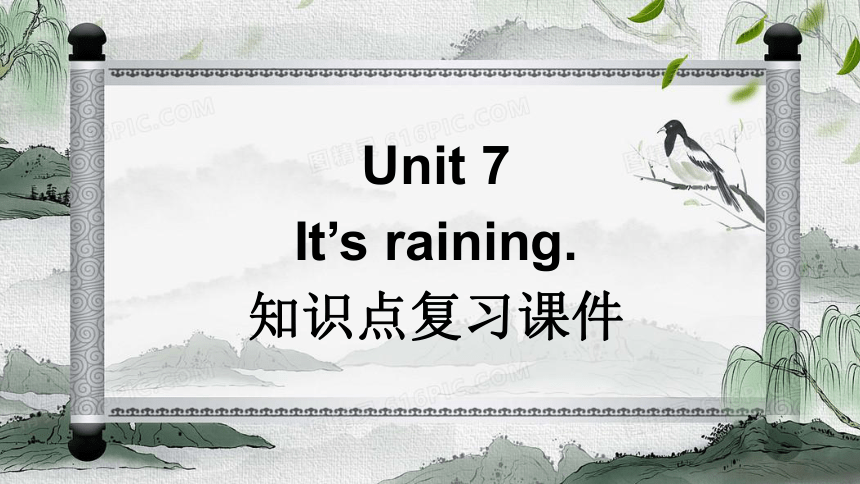 | |
| 格式 | zip | ||
| 文件大小 | 1.3MB | ||
| 资源类型 | 教案 | ||
| 版本资源 | 人教新目标(Go for it)版 | ||
| 科目 | 英语 | ||
| 更新时间 | 2023-05-08 12:53:04 | ||
图片预览

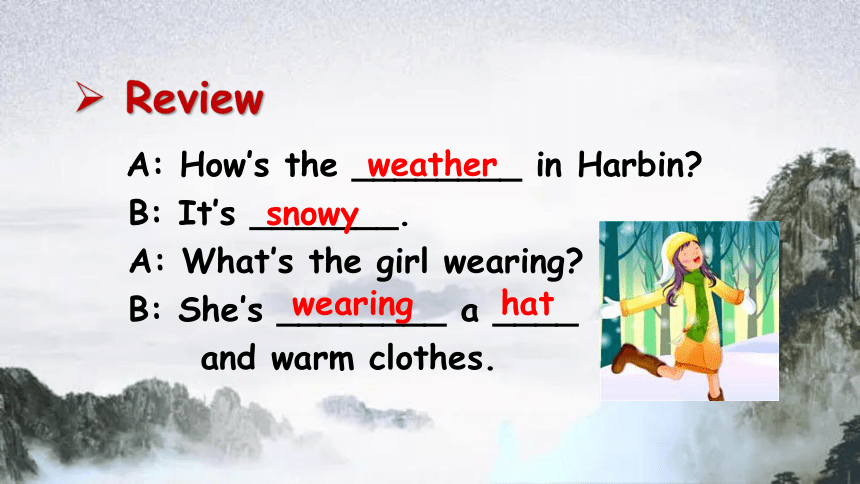
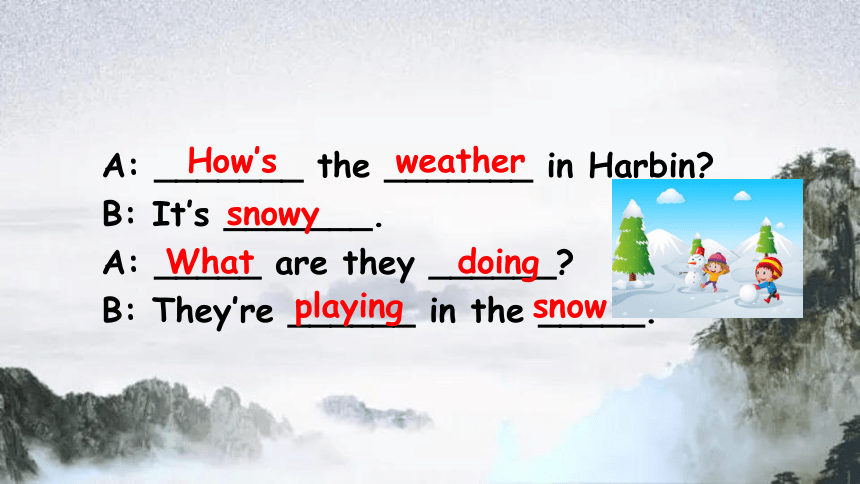
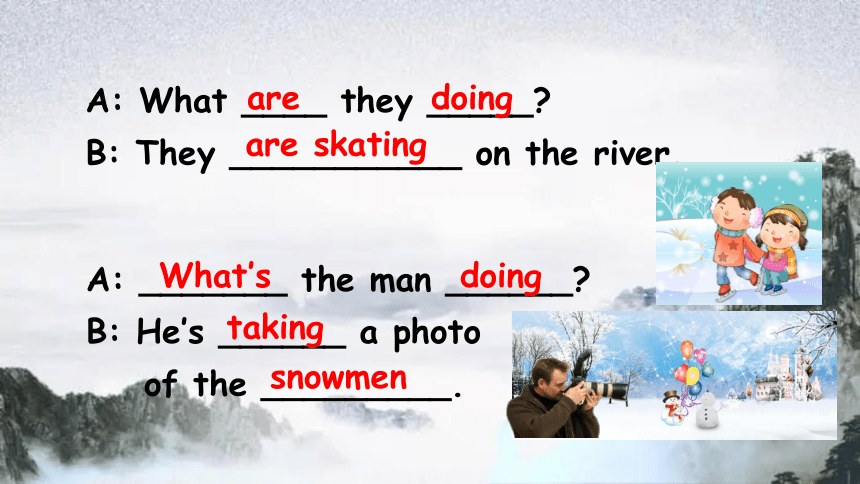
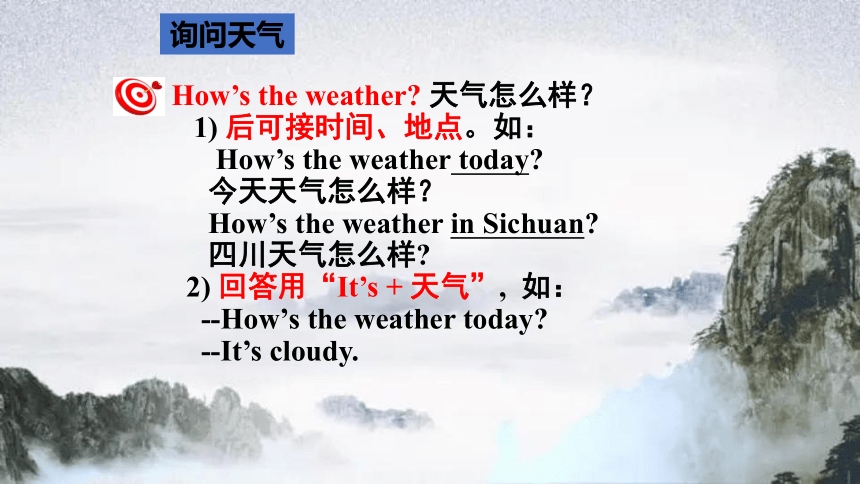
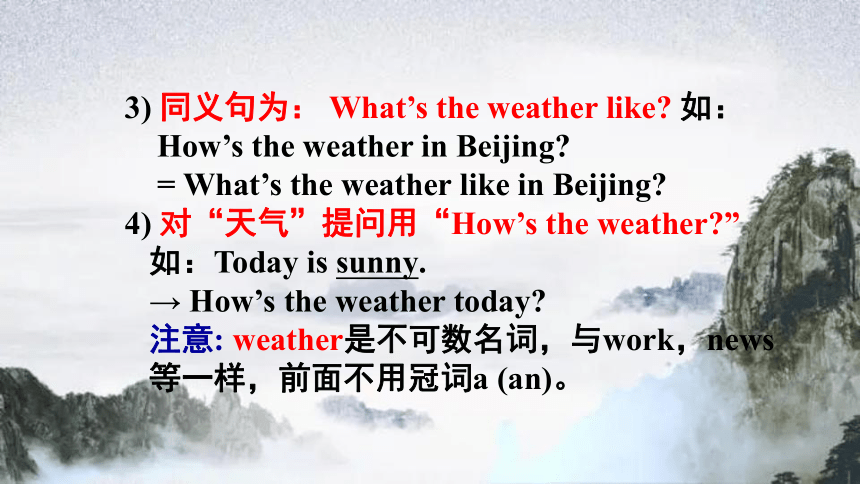
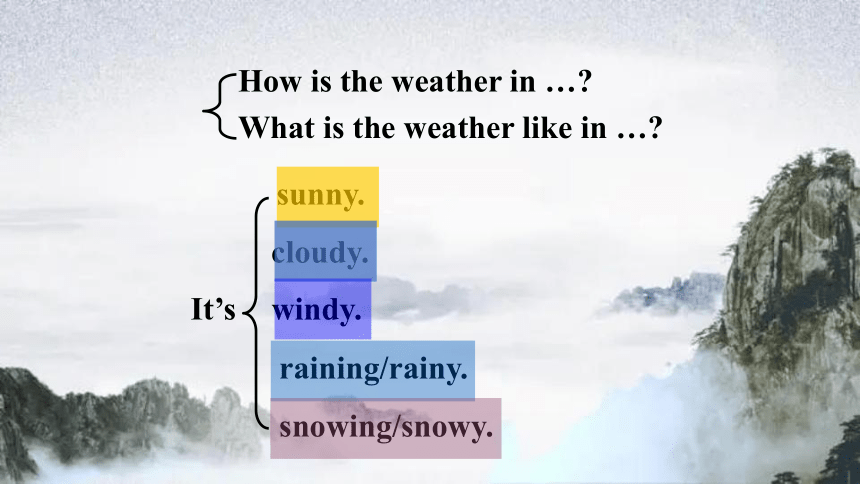
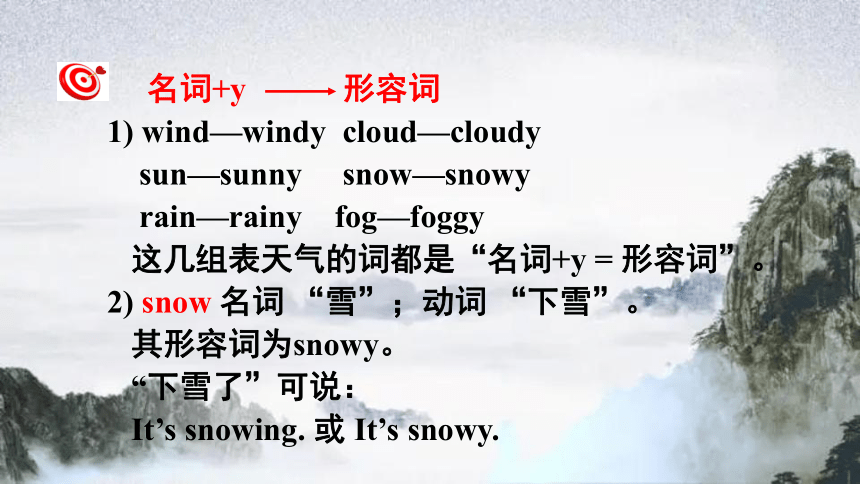
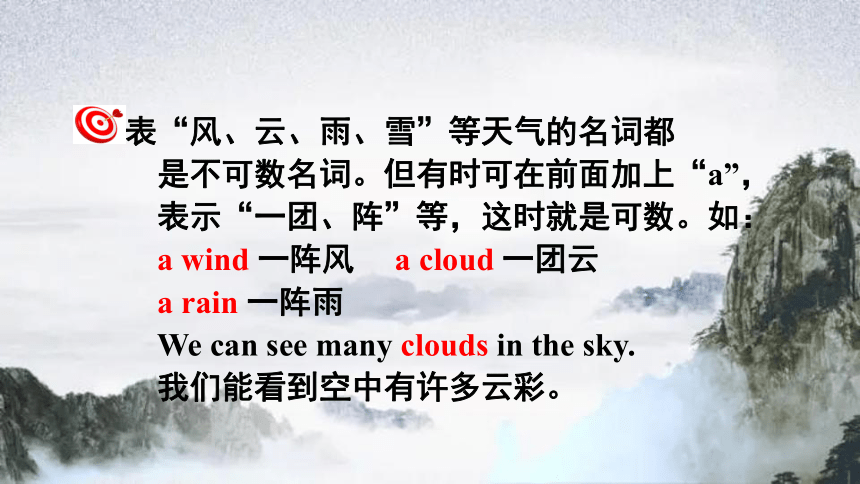
文档简介
(共24张PPT)
Unit 7
It’s raining.
知识点复习课件
A: How’s the ________ in Harbin
B: It’s _______.
A: What’s the girl wearing
B: She’s ________ a ____
and warm clothes.
snowy
weather
wearing hat
Review
A: _______ the _______ in Harbin
B: It’s _______.
A: _____ are they ______
B: They’re ______ in the _____.
How’s weather
snowy
What doing
playing snow
A: What ____ they _____
B: They ___________ on the river.
A: _______ the man ______
B: He’s ______ a photo
of the _________.
are doing
are skating
What’s doing
taking
snowmen
How’s the weather 天气怎么样?
1) 后可接时间、地点。如:
How’s the weather today
今天天气怎么样?
How’s the weather in Sichuan
四川天气怎么样
2) 回答用“It’s + 天气”, 如:
--How’s the weather today
--It’s cloudy.
询问天气
3) 同义句为: What’s the weather like 如:
How’s the weather in Beijing
= What’s the weather like in Beijing
4) 对“天气”提问用“How’s the weather ”
如:Today is sunny.
→ How’s the weather today
注意: weather是不可数名词,与work,news
等一样,前面不用冠词a (an)。
How is the weather in …
What is the weather like in …
sunny.
cloudy.
It’s windy.
raining/rainy.
snowing/snowy.
名词+y 形容词
1) wind—windy cloud—cloudy
sun—sunny snow—snowy
rain—rainy fog—foggy
这几组表天气的词都是“名词+y = 形容词”。
2) snow 名词 “雪”;动词 “下雪”。
其形容词为snowy。
“下雪了”可说:
It’s snowing. 或 It’s snowy.
表“风、云、雨、雪”等天气的名词都
是不可数名词。但有时可在前面加上“a”,
表示“一团、阵”等,这时就是可数。如:
a wind 一阵风 a cloud 一团云
a rain 一阵雨
We can see many clouds in the sky.
我们能看到空中有许多云彩。
It's raining!现在正在下雨!
【拓展延伸】表示天气的形容词:
rain(雨)→rainy(下雨的)
wind(风)→windy(有风的)
cloud(云)→cloudy(多云的)
snow(雪)→snowy(有雪的)
sun(太阳)→sunny(晴朗的)(双写n,再加y)
fog(雾)→foggy(多雾的)(双写g,再加y)
Could you just tell him to call me back?你能告诉他给我回电话吗?
tell sb.to do sth.告诉某人做某事
其否定形式为tell sb.not to do sth.,意为“告诉某人不要做某事”。
call sb.back给某人回电话
【特别提醒】sb.若是名词也可说成“call back sb.”,但若是代词作宾语时,只能放在中间。call Tom back=call back Tom给汤姆回电话,但“call me back”不能说“call back me”。
【拓展延伸】back作副词,意为“回来;回原处”,常与动词一起构成动词短语。
call back回电话 come back回来
get back返回 go back回去
pay back偿还 bring back拿回
Could you (please)…?请你……好吗?/我可以……吗?
用来表示委婉的请求。该句型中,could也可换成can,但 could在语气上比can更加委婉、客气。
e.g.Can/Could you please open the window?It's too hot.
请你把窗户打开好吗?太热了。
【拓展延伸】对上述句型的肯定回答可以用“Sure./Certainly./Yes,please./No problem.”等。否定回答可用“I'm sorry,but…”。
Sure,no problem.当然,没问题。
no problem意为“没问题”,表示同意或者没关系。
【拓展延伸】还用于回答道谢、道歉、询问能力等。
【易混辨析】problem与question
problem 所指的问题总是与困难联系着,表示“有待于解决的问题”。
question 所指的问题总是和疑问联系着,表示“有待回答的问题”,它常与ask,answer 连用。
I'm sitting by the pool and drinking orange juice.我正坐在池塘边,喝着橘子汁。
by用作介词,在此意为“在……旁边”,相当于beside/next to。
【拓展延伸】介词by的其他用法:
①指“移动的方向”,相当于past,along,across,意思是“经过,沿着,横过”。
②指“时间”,意思是“不迟于,当(某时候)到了”。
③指“凭据”,意思是“根据,按照”。
It's hot in your country now,isn't it?你们国家现在很热,对吧?
该句为反意疑问句,也叫作附加疑问句。是由“陈述句+附加词句”构成,表示提问者有一定的主见,但没有把握,希望对方来证实。反意疑问句在结构上要遵循“前肯后否,前否
后肯”的原则。
—He is a doctor,isn't he?他是医生,不是吗?
—Yes,he is.不,他是。
—He doesn't like hamburgers,does he?他不喜欢汉堡包,是吗?
—No,he doesn't.是的,他不喜欢。
【拓展延伸】当陈述部分含有no,few,little,never等否定含义的词时,附加疑问部分应用肯定形式。
e.g.Tom is never late for school,is he?汤姆上学从来不迟到,是吗?
【巧学妙记】
反意疑问句:前肯后否是自然,前否后肯也常见。问句not若出现,必须缩写是习惯。还有一点要注意,代词来把主语担。人称和数要相符,前后时态不可变。
现在进行时与一般现在进行时的比较
现在进行时 一般现在时
概念 表示现在或现阶段正在进行的动作。 表示经常性或习惯性的动作或存在的状态,也表示主语具备的性格和能力,或陈述客观真理。
构成 主语+be(am/is/are)+现在分词+其他. 主语+be(am/is/are)+其他.主语+be(am/is/are)+其他.
时间状语或标志词 now, right now,look,listen等。 every day, often, usually, always, sometimes, in the morning等。
1. It’s ______ (sun) today, but it’s ______ (wind).
2. --Look, What _____ they ______ (do)
--They ___________ (play) tennis.
3. There ___ (be) some milk in the glass.
sunny
windy
are
doing
are playing
is
Ⅰ.根据提示完成句子。
Exercises
4. Can he ____(go) shopping with me
5. Lucy _________ (have) lunch at school now.
She usually _____ (have) lunch at school.
6. It’s _______ (sun) today. The sun is
shining brightly.
go
is having
has
sunny
7. In spring, the weather is _______ (温暖的)
in Kunming.
8. It often s _______ in the north of China
in winter.
9. In Beijing, the weather is not h _______
but dry in spring.
warm
umid
nows
1. 我正坐在泳池边喝橙汁。
I’m _______ by the pool and _________
orange juice.
2. 北京的春天温暖,秋天凉爽。
_____ _______ in spring and _______
in autumn in Beijing.
sitting
It’s warm cool
drinking
Ⅱ.完成句子。
3. 这儿是晴天,很暖和,而且很悠闲。
It’s _______ and _______, and it’s very
_________ here.
4. 你暑假过得怎么样?
__________________________________
5. 下雨的时候我通常在家看书。
I usually read books at home ______
____ ________.
when
it’s raining
warm sunny
How’s your summer vacation going
relaxing
Unit 7
It’s raining.
知识点复习课件
A: How’s the ________ in Harbin
B: It’s _______.
A: What’s the girl wearing
B: She’s ________ a ____
and warm clothes.
snowy
weather
wearing hat
Review
A: _______ the _______ in Harbin
B: It’s _______.
A: _____ are they ______
B: They’re ______ in the _____.
How’s weather
snowy
What doing
playing snow
A: What ____ they _____
B: They ___________ on the river.
A: _______ the man ______
B: He’s ______ a photo
of the _________.
are doing
are skating
What’s doing
taking
snowmen
How’s the weather 天气怎么样?
1) 后可接时间、地点。如:
How’s the weather today
今天天气怎么样?
How’s the weather in Sichuan
四川天气怎么样
2) 回答用“It’s + 天气”, 如:
--How’s the weather today
--It’s cloudy.
询问天气
3) 同义句为: What’s the weather like 如:
How’s the weather in Beijing
= What’s the weather like in Beijing
4) 对“天气”提问用“How’s the weather ”
如:Today is sunny.
→ How’s the weather today
注意: weather是不可数名词,与work,news
等一样,前面不用冠词a (an)。
How is the weather in …
What is the weather like in …
sunny.
cloudy.
It’s windy.
raining/rainy.
snowing/snowy.
名词+y 形容词
1) wind—windy cloud—cloudy
sun—sunny snow—snowy
rain—rainy fog—foggy
这几组表天气的词都是“名词+y = 形容词”。
2) snow 名词 “雪”;动词 “下雪”。
其形容词为snowy。
“下雪了”可说:
It’s snowing. 或 It’s snowy.
表“风、云、雨、雪”等天气的名词都
是不可数名词。但有时可在前面加上“a”,
表示“一团、阵”等,这时就是可数。如:
a wind 一阵风 a cloud 一团云
a rain 一阵雨
We can see many clouds in the sky.
我们能看到空中有许多云彩。
It's raining!现在正在下雨!
【拓展延伸】表示天气的形容词:
rain(雨)→rainy(下雨的)
wind(风)→windy(有风的)
cloud(云)→cloudy(多云的)
snow(雪)→snowy(有雪的)
sun(太阳)→sunny(晴朗的)(双写n,再加y)
fog(雾)→foggy(多雾的)(双写g,再加y)
Could you just tell him to call me back?你能告诉他给我回电话吗?
tell sb.to do sth.告诉某人做某事
其否定形式为tell sb.not to do sth.,意为“告诉某人不要做某事”。
call sb.back给某人回电话
【特别提醒】sb.若是名词也可说成“call back sb.”,但若是代词作宾语时,只能放在中间。call Tom back=call back Tom给汤姆回电话,但“call me back”不能说“call back me”。
【拓展延伸】back作副词,意为“回来;回原处”,常与动词一起构成动词短语。
call back回电话 come back回来
get back返回 go back回去
pay back偿还 bring back拿回
Could you (please)…?请你……好吗?/我可以……吗?
用来表示委婉的请求。该句型中,could也可换成can,但 could在语气上比can更加委婉、客气。
e.g.Can/Could you please open the window?It's too hot.
请你把窗户打开好吗?太热了。
【拓展延伸】对上述句型的肯定回答可以用“Sure./Certainly./Yes,please./No problem.”等。否定回答可用“I'm sorry,but…”。
Sure,no problem.当然,没问题。
no problem意为“没问题”,表示同意或者没关系。
【拓展延伸】还用于回答道谢、道歉、询问能力等。
【易混辨析】problem与question
problem 所指的问题总是与困难联系着,表示“有待于解决的问题”。
question 所指的问题总是和疑问联系着,表示“有待回答的问题”,它常与ask,answer 连用。
I'm sitting by the pool and drinking orange juice.我正坐在池塘边,喝着橘子汁。
by用作介词,在此意为“在……旁边”,相当于beside/next to。
【拓展延伸】介词by的其他用法:
①指“移动的方向”,相当于past,along,across,意思是“经过,沿着,横过”。
②指“时间”,意思是“不迟于,当(某时候)到了”。
③指“凭据”,意思是“根据,按照”。
It's hot in your country now,isn't it?你们国家现在很热,对吧?
该句为反意疑问句,也叫作附加疑问句。是由“陈述句+附加词句”构成,表示提问者有一定的主见,但没有把握,希望对方来证实。反意疑问句在结构上要遵循“前肯后否,前否
后肯”的原则。
—He is a doctor,isn't he?他是医生,不是吗?
—Yes,he is.不,他是。
—He doesn't like hamburgers,does he?他不喜欢汉堡包,是吗?
—No,he doesn't.是的,他不喜欢。
【拓展延伸】当陈述部分含有no,few,little,never等否定含义的词时,附加疑问部分应用肯定形式。
e.g.Tom is never late for school,is he?汤姆上学从来不迟到,是吗?
【巧学妙记】
反意疑问句:前肯后否是自然,前否后肯也常见。问句not若出现,必须缩写是习惯。还有一点要注意,代词来把主语担。人称和数要相符,前后时态不可变。
现在进行时与一般现在进行时的比较
现在进行时 一般现在时
概念 表示现在或现阶段正在进行的动作。 表示经常性或习惯性的动作或存在的状态,也表示主语具备的性格和能力,或陈述客观真理。
构成 主语+be(am/is/are)+现在分词+其他. 主语+be(am/is/are)+其他.主语+be(am/is/are)+其他.
时间状语或标志词 now, right now,look,listen等。 every day, often, usually, always, sometimes, in the morning等。
1. It’s ______ (sun) today, but it’s ______ (wind).
2. --Look, What _____ they ______ (do)
--They ___________ (play) tennis.
3. There ___ (be) some milk in the glass.
sunny
windy
are
doing
are playing
is
Ⅰ.根据提示完成句子。
Exercises
4. Can he ____(go) shopping with me
5. Lucy _________ (have) lunch at school now.
She usually _____ (have) lunch at school.
6. It’s _______ (sun) today. The sun is
shining brightly.
go
is having
has
sunny
7. In spring, the weather is _______ (温暖的)
in Kunming.
8. It often s _______ in the north of China
in winter.
9. In Beijing, the weather is not h _______
but dry in spring.
warm
umid
nows
1. 我正坐在泳池边喝橙汁。
I’m _______ by the pool and _________
orange juice.
2. 北京的春天温暖,秋天凉爽。
_____ _______ in spring and _______
in autumn in Beijing.
sitting
It’s warm cool
drinking
Ⅱ.完成句子。
3. 这儿是晴天,很暖和,而且很悠闲。
It’s _______ and _______, and it’s very
_________ here.
4. 你暑假过得怎么样?
__________________________________
5. 下雨的时候我通常在家看书。
I usually read books at home ______
____ ________.
when
it’s raining
warm sunny
How’s your summer vacation going
relaxing
同课章节目录
- Unit 1 Can you play the guitar?
- Section A
- Section B
- Unit 2 What time do you go to school?
- Section A
- Section B
- Unit 3 How do you get to school?
- Section A
- Section B
- Unit 4 Don't eat in class.
- Section A
- Section B
- Unit 5 Why do you like pandas?
- Section A
- Section B
- Unit 6 I'm watching TV.
- Section A
- Section B
- Review of Units 1-6
- Unit 7 It's raining!
- Section A
- Section B
- Unit 8 Is there a post office near here?
- Section A
- Section B
- Unit 9 What does he look like?
- Section A
- Section B
- Unit 10 I'd like some noodles.
- Section A
- Section B
- Unit 11 How was your school trip?
- Section A
- Section B
- Unit 12 What did you do last weekend?
- Section A
- Section B
